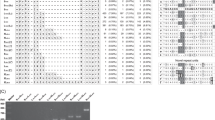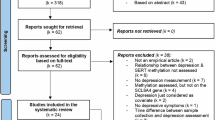Abstract
Serotonin-transporter-linked polymorphic region (5-HTTLPR), a variable number of tandem repeats in the promoter region of serotonin transporter gene, is classified into short (S) and long (L) alleles. Initial case-control association studies claiming the risks of the S allele in depression and anxiety were not completely supported by recent studies. However, most studies, especially those on East Asian populations, have overlooked the complexity of 5-HTTLPR, which involves multiple different alleles with distinct functional properties. To address this issue, distinguishing multiple 5-HTTLPR alleles is essential. Here, using the 5-HTTLPR genotypes previously determined by exhaustive Sanger sequencing of approximately 1,500 Japanese subjects and their comprehensive SNP data, we constructed a method for 5-HTTLPR genotype imputation. We identified 28 tag SNPs for the imputation of four major 5-HTTLPR alleles, which collectively account for 97.6% of 5-HTTLPR alleles in the Japanese population. Our imputation method, achieved an accuracy of 0.872 in cross-validation, will contribute to association analysis of 5-HTTLPR in the Japanese subjects.
This is a preview of subscription content, access via your institution
Access options
Subscribe to this journal
Receive 12 print issues and online access
$259.00 per year
only $21.58 per issue
Buy this article
- Purchase on SpringerLink
- Instant access to full article PDF
Prices may be subject to local taxes which are calculated during checkout



Similar content being viewed by others
References
Kanova M, Kohout P. Serotonin-its synthesis and roles in the healthy and the critically ill. Int J Mol Sci. 2021;22:4837.
Mohammad-Zadeh LF, Moses L, Gwaltney-Brant SM. Serotonin: a review. J Vet Pharm Ther. 2008;31:187–99.
Berger M, Gray JA, Roth BL. The expanded biology of serotonin. Annu Rev Med. 2009;60:355–66.
Canli T, Lesch KP. Long story short: the serotonin transporter in emotion regulation and social cognition. Nat Neurosci. 2007;10:1103–9.
Barnes NM, Sharp T. A review of central 5-HT receptors and their function. Neuropharmacology. 1999;38:1083–152.
Iurescia S, Seripa D, Rinaldi M. Role of the 5-HTTLPR and SNP promoter polymorphisms on serotonin transporter gene expression: a closer look at genetic architecture and in vitro functional studies of common and uncommon allelic variants. Mol Neurobiol. 2016;53:5510–26.
Heils A, Teufel A, Petri S, Stöber G, Riederer P, Bengel D, et al. Allelic variation of human serotonin transporter gene expression. J Neurochem. 1996;66:2621–4.
Lesch KP, Bengel D, Heils A, Sabol SZ, Greenberg BD, Petri S, et al. Association of anxiety-related traits with a polymorphism in the serotonin transporter gene regulatory region. Science. 1996;274:1527–31.
Heils A, Mössner R, Lesch KP. The human serotonin transporter gene polymorphism–basic research and clinical implications. J Neural Transm. 1997;104:1005–14.
Caspi A, Sugden K, Moffitt TE, Taylor A, Craig IW, Harrington H, et al. Influence of life stress on depression: moderation by a polymorphism in the 5-HTT gene. Science. 2003;301:386–9.
Sen S, Burmeister M, Ghosh D. Meta-analysis of the association between a serotonin transporter promoter polymorphism (5-HTTLPR) and anxiety-related personality traits. Am J Med Genet B Neuropsychiatr Genet. 2004;127b:85–9.
Culverhouse RC, Saccone NL, Horton AC, Ma Y, Anstey KJ, Banaschewski T, et al. Collaborative meta-analysis finds no evidence of a strong interaction between stress and 5-HTTLPR genotype contributing to the development of depression. Mol Psychiatry. 2018;23:133–42.
Border R, Johnson EC, Evans LM, Smolen A, Berley N, Sullivan PF, et al. No support for historical candidate gene or candidate gene-by-interaction hypotheses for major depression across multiple large samples. Am J Psychiatry. 2019;176:376–87.
Ikegame T, Hidaka Y, Nakachi Y, Murata Y, Watanabe R, Sugawara H, et al. Identification and functional characterization of the extremely long allele of the serotonin transporter-linked polymorphic region. Transl Psychiatry. 2021;11:119.
Hu XZ, Lipsky RH, Zhu G, Akhtar LA, Taubman J, Greenberg BD, et al. Serotonin transporter promoter gain-of-function genotypes are linked to obsessive-compulsive disorder. Am J Hum Genet. 2006;78:815–26.
Nakamura M, Ueno S, Sano A, Tanabe H. The human serotonin transporter gene linked polymorphism (5-HTTLPR) shows ten novel allelic variants. Mol Psychiatry. 2000;5:32–8.
Ikegame T, Bundo M, Okada N, Murata Y, Koike S, Sugawara H, et al. Promoter activity-based case-control association study on SLC6A4 highlighting hypermethylation and altered amygdala volume in male patients with schizophrenia. Schizophr Bull. 2020;46:1577–86.
Marchini J, Howie B. Genotype imputation for genome-wide association studies. Nat Rev Genet. 2010;11:499–511.
Li N, Stephens M. Modeling linkage disequilibrium and identifying recombination hotspots using single-nucleotide polymorphism data. Genetics. 2003;165:2213–33.
Naito T, Suzuki K, Hirata J, Kamatani Y, Matsuda K, Toda T, et al. A deep learning method for HLA imputation and trans-ethnic MHC fine-mapping of type 1 diabetes. Nat Commun. 2021;12:1639.
Border R, Smolen A, Corley RP, Stallings MC, Brown SA, Conger RD, et al. Imputation of behavioral candidate gene repeat variants in 486,551 publicly-available UK Biobank individuals. Eur J Hum Genet. 2019;27:963–9.
Ninomiya T, Nakaji S, Maeda T, Yamada M, Mimura M, Nakashima K, et al. Study design and baseline characteristics of a population-based prospective cohort study of dementia in Japan: the Japan Prospective Studies Collaboration for Aging and Dementia (JPSC-AD). Environ Health Prev Med. 2020;25:64.
Akiyama M, Ishigaki K, Sakaue S, Momozawa Y, Horikoshi M, Hirata M, et al. Characterizing rare and low-frequency height-associated variants in the Japanese population. Nat Commun. 2019;10:4393.
Stephens M, Smith NJ, Donnelly P. A new statistical method for haplotype reconstruction from population data. Am J Hum Genet. 2001;68:978–89.
Stephens M, Scheet P. Accounting for decay of linkage disequilibrium in haplotype inference and missing-data imputation. Am J Hum Genet. 2005;76:449–62.
Nassar LR, Barber GP, Benet-Pagès A, Casper J, Clawson H, Diekhans M, et al. The UCSC Genome Browser database: 2023 update. Nucleic Acids Res. 2023;51:D1188–d95.
Funding
This work was supported by JSPS KAKENHI grant numbers JP23H02840, JP23H03838, and JP22K07583, and by AMED grant number JP19dm0207074, JP23dk0207053, JP24wm0625302, and JP24wm0625001, and by JST Moonshot R&D Grant Number JPMJMS2021.
Author information
Authors and Affiliations
Corresponding authors
Ethics declarations
Competing interests
Some of the authors declared financial and non-financial relationships and activities, and conflicts of interest regarding this manuscript as indicated in the supplementary materials. The sponsor had no role in study design, data collection, data analysis, data interpretation or writing of the report.
Additional information
Publisher’s note Springer Nature remains neutral with regard to jurisdictional claims in published maps and institutional affiliations.
Supplementary information
Rights and permissions
Springer Nature or its licensor (e.g. a society or other partner) holds exclusive rights to this article under a publishing agreement with the author(s) or other rightsholder(s); author self-archiving of the accepted manuscript version of this article is solely governed by the terms of such publishing agreement and applicable law.
About this article
Cite this article
Yanagida, Y., Naka, I., Nakachi, Y. et al. Development of a method for the imputation of the multi-allelic serotonin-transporter-linked polymorphic region (5-HTTLPR) in the Japanese population. J Hum Genet 70, 41–45 (2025). https://doi.org/10.1038/s10038-024-01296-9
Received:
Revised:
Accepted:
Published:
Issue date:
DOI: https://doi.org/10.1038/s10038-024-01296-9



